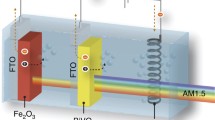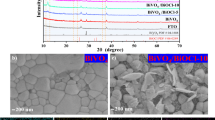Abstract
Dye-sensitized photoelectrochemical tandem cells have shown the promise for light driven hydrogen production from water owing to the low cost, wide absorption spectra in the visible region and ease to process of their constitutive photoelectrode materials. However, most photo-driven water splitting photoelectrochemical cells driven by organic dye sensitized solar cells exhibit unsatisfactory hydrogen evolution rate, primarily attributed to their poor light capturing ability and low photocurrent performance. Here we present the construction of a tandem system consisting of an organic blue-colored S5 sensitizer-based dye-sensitized photoelectrochemical cell (DSPEC) wired in series with three spectral-complemental dyes BTA-2, APP-3 and APP-1 sensitizers-based dye-sensitized solar cell (DSC), respectively. The two spectral-complemental chromophores were used in DSC and DSPEC to ensure that the full solar spectrum could be absorbed as much as possible. The results showed that the photocurrent of tandem device was closely related to the open-circuit voltage (Voc) of sensitized DSC, in which the tandem configuration consisting of S5 based DSPEC and BTA-2 based DSC gave the best photocurrent. On this basis, tandem device with the only light energy and no external applied electrical bias was further constructed of BTA-2 based 2-junction DSC and S5 based DSPEC and obtained a photocurrent of 500 µA cm−2 for hydrogen generation. Furthermore, I−/I3− was used as a redox couple between dye regeneration and O2 production on the surface of Pt-IrO2/WO3. The strategy opens up the application of pure organic dyes in DSC/DSPEC tandem device.
Similar content being viewed by others
References
Lewis NS, Nocera DG. Proc Natl Acad Sci USA, 2006, 103: 15729–15735
Dresselhaus MS, Thomas IL. Nature, 2001, 414: 332–337
Murray J, King D. Nature, 2012, 481: 433–435
Hammarstrom L, Hammes-Schiffer S. Acc Chem Res, 2009, 42: 1859–1860
Service RF. Science, 2005, 309: 548–551
Grätzel M. Nature, 2001, 414: 338–344
Yang Y, Niu S, Han D, Liu T, Wang G, Li Y. Adv Energy Mater, 2017, 7: 1700555
Yao T, An X, Han H, Chen JQ, Li C. Adv Energy Mater, 2018, 8: 1800210
Tolod K, Hernández S, Russo N. Catalysts, 2017, 7: 13
Fujishima A, Honda K. Nature, 1972, 238: 37–38
Xu P, McCool NS, Mallouk TE. Nano Today, 2017, 14: 42–58
Brillet J, Cornuz M, Formal FL, Yum JH, Grätzel M, Sivula K. J Mater Res, 2011, 25: 17–24
Khaselev O, Turner JA. Science, 1998, 280: 425–427
Abe R, Higashi M, Domen K. ChemSusChem, 2011, 4: 228–237
Weber MF. J Electrochem Soc, 1984, 131: 1258–1265
Zhang K, Ma M, Li P, Wang DH, Park JH. Adv Energy Mater, 2016, 6: 1600602
Kochuveedu ST, Jang YH, Kim DH. Chem Soc Rev, 2013, 42: 8467–8493
Alexander BD, Kulesza PJ, Rutkowska I, Solarska R, Augustynski J. J Mater Chem, 2008, 18: 2298–2303
Shen S, Lindley SA, Chen X, Zhang JZ. Energy Environ Sci, 2016, 9: 2744–2775
Ashford DL, Gish MK, Vannucci AK, Brennaman MK, Templeton JL, Papanikolas JM, Meyer TJ. Chem Rev, 2015, 115: 13006–13049
Li F, Fan K, Xu B, Gabrielsson E, Daniel Q, Li L, Sun L. J Am Chem Soc, 2015, 137: 9153–9159
Li F, Yang H, Li W, Sun L. Joule, 2018, 2: 36–60
Zhang B, Sun L. Chem Soc Rev, 2019, 48: 2216–2264
Yu Y, Curtze A, Wu Y. Sci China Chem, 2018, 61: 1203–1204
Mathew S, Yella A, Gao P, Humphry-Baker R, Curchod BFE, Ashari-Astani N, Tavernelli I, Rothlisberger U, Nazeeruddin MK, Grätzel M. Nat Chem, 2014, 6: 242–247
Sheng J, Hu L, Mo L, Ye J, Dai S. Sci China Chem, 2017, 60: 822–828
Shen Z, Xu B, Liu P, Hu Y, Yu Y, Ding H, Kloo L, Hua J, Sun L, Tian H. J Mater Chem A, 2017, 5: 1242–1247
Mao J, Guo F, Ying W, Wu W, Li J, Hua J. Chem Asian J, 2012, 7: 982–991
Ying W, Yang J, Wielopolski M, Moehl T, Moser JE, Comte P, Hua J, Zakeeruddin SM, Tian H, Grätzel M. Chem Sci, 2014, 5: 206–214
Nazeeruddin MK, Kay A, Rodicio I, Humphry-Baker R, Mueller E, Liska P, Vlachopoulos N, Graetzel M. J Am Chem Soc, 1993, 115: 6382–6390
Click KA, Beauchamp DR, Huang Z, Chen W, Wu Y. J Am Chem Soc, 2016, 138: 1174–1179
Wang D, Eberhart MS, Sheridan MV, Hu K, Sherman BD, Nayak A, Wang Y, Marquard SL, Dares CJ, Meyer TJ. Proc Natl Acad Sci USA, 2018, 115: 8523–8528
Alibabaei L, Dillon RJ, Reilly CE, Brennaman MK, Wee KR, Marquard SL, Papanikolas JM, Meyer TJ. ACS Appl Mater Interfaces, 2017, 9: 39018–39026
Eberhart MS, Wang D, Sampaio RN, Marquard SL, Shan B, Brennaman MK, Meyer GJ, Dares C, Meyer TJ. J Am Chem Soc, 2017, 139: 16248–16255
Wee KR, Sherman BD, Brennaman MK, Sheridan MV, Nayak A, Alibabaei L, Meyer TJ. J Mater Chem A, 2016, 4: 2969–2975
Sheridan MV, Wang Y, Wang D, Troian-Gautier L, Dares CJ, Sherman BD, Meyer TJ. Angew Chem Int Ed, 2018, 57: 3449–3453
Li Z, Wang W, Liao S, Liu M, Qi Y, Ding C, Li C. Energy Environ Sci, 2019, 12: 631–639
Abe R, Shinmei K, Koumura N, Hara K, Ohtani B. J Am Chem Soc, 2013, 135: 16872–16884
Zhang H, Li H, Wang Z, Zheng Z, Wang P, Liu Y, Zhang X, Qin X, Dai Y, Huang B. Appl Catal B-Environ, 2018, 238: 586–591
Sherman BD, Sheridan MV, Wee KR, Marquard SL, Wang D, Alibabaei L, Ashford DL, Meyer TJ. J Am Chem Soc, 2016, 138: 16745–16753
Sherman BD, Bergkamp JJ, Brown CL, Moore AL, Gust D, Moore TA. Energy Environ Sci, 2016, 9: 1812–1817
Brillet J, Yum JH, Cornuz M, Hisatomi T, Solarska R, Augustynski J, Graetzel M, Sivula K. Nat Photon, 2012, 6: 824–828
Li Z, Wang W, Ding C, Wang Z, Liao S, Li C. Energy Environ Sci, 2017, 10: 765–771
Sokol KP, Robinson WE, Warnan J, Kornienko N, Nowaczyk MM, Ruff A, Zhang JZ, Reisner E. Nat Energy, 2018, 3: 944–951
Huang X, Zhao G, Wang G. J Mater Chem A, 2017, 5: 24631–24635
Ding X, Gao Y, Fan T, Ji Y, Zhang L, Yu Z, Ahlquist MSG, Sun L. Electrochim Acta, 2016, 215: 682–688
Acknowledgements
This work was supported by the National Natural Science Foundation of China (21971064, 21421004, 21772040, 21572062), Shanghai Municipal Science and Technology Major Project (2018SHZDZX03), the Fundamental Research Funds for the Central Universities (50321101918001, 222201717003) and the Programme of Introducing Talents of Discipline to Universities (B16017). The authors thank Research Center of Analysis and Test of East China University of Science and Technology for the help on the characterization.
Author information
Authors and Affiliations
Corresponding author
Ethics declarations
Conflict of interest The authors declare that they have no conflict of interest.
Supporting Information
11426_2019_9596_MOESM1_ESM.pdf
Photo-driven water splitting photoelectrochemical cells by tandem organic dye sensitized solar cells with I−/I3− as redox mediator
Rights and permissions
About this article
Cite this article
Zhang, S., Ye, H., Ding, H. et al. Photo-driven water splitting photoelectrochemical cells by tandem organic dye sensitized solar cells with I−/I3− as redox mediator. Sci. China Chem. 63, 228–236 (2020). https://doi.org/10.1007/s11426-019-9596-7
Received:
Accepted:
Published:
Issue Date:
DOI: https://doi.org/10.1007/s11426-019-9596-7




